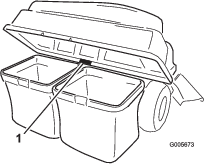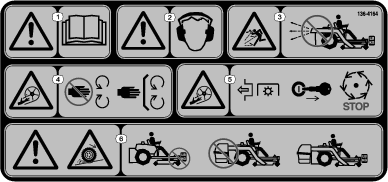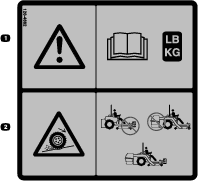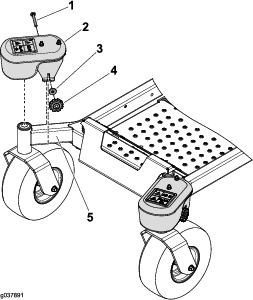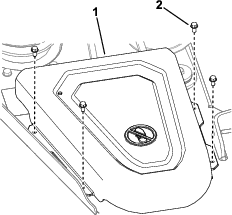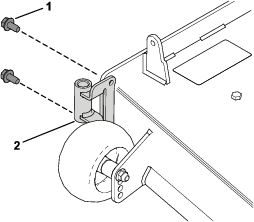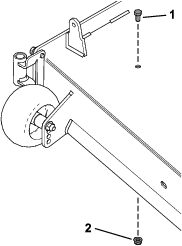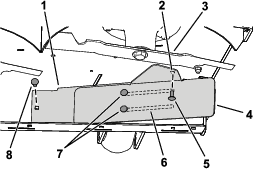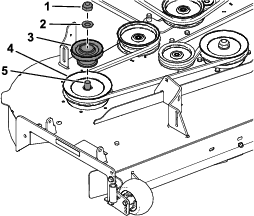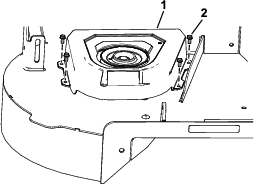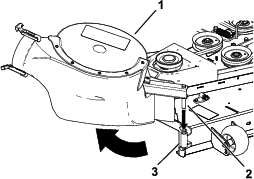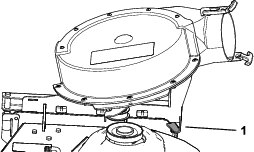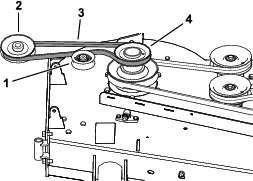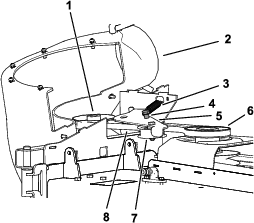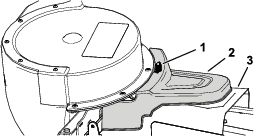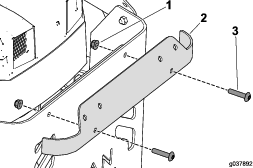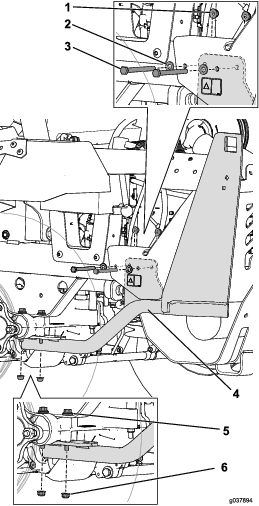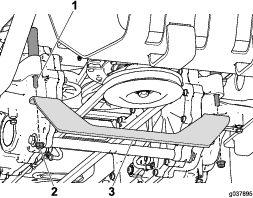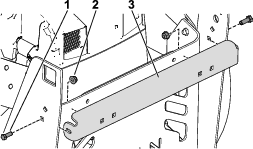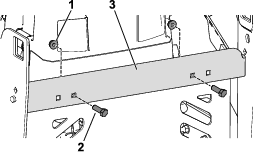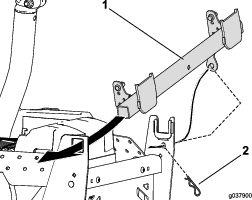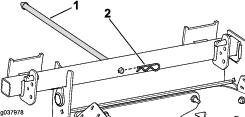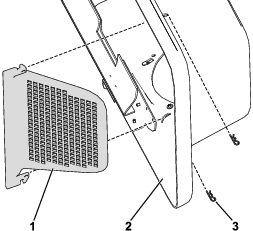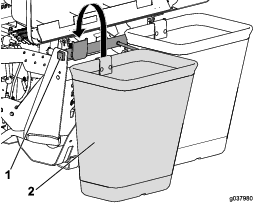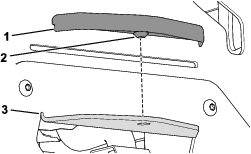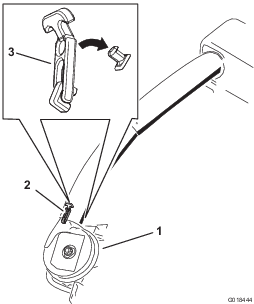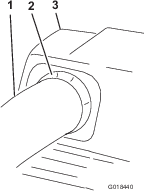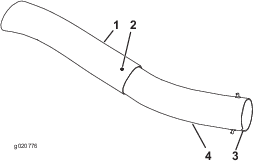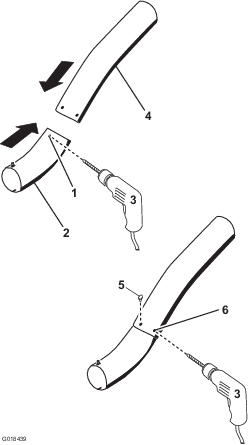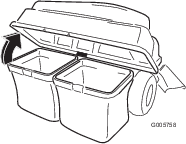Maintenance
Note: Determine the left and right sides of the machine from the normal operating position.
Recommended Maintenance Schedule(s)
| Maintenance Service Interval | Maintenance Procedure |
|---|---|
| After the first 8 hours |
|
| After each use |
|
| Every 25 hours |
|
| Every 100 hours |
|
Warning
If you leave the key in the key switch, someone could accidently start the engine and seriously injure you or other bystanders.
Remove the key and disconnect the wire from the spark plug before you do any maintenance. Set the wire aside so that it does not accidentally contact the spark plug.
Warning
Engines can become hot when they are operating. Severe burns can occur from contacting hot surfaces.
Allow engines, especially the muffler, to cool before touching.
Warning
Debris, such as leaves, grass, or brush can catch fire. A fire in the engine area can cause personal injury and property damage.
-
Keep the engine and muffler area free of debris accumulation.
-
Take care when opening the bagger cover to keep debris from falling onto the engine and muffler area.
-
Allow the machine to cool before storing it.
Preparing for Maintenance
Do the following steps before preforming maintenance on the machine:
-
Park the machine on a level surface.
-
Disengage the PTO, move the motion control levers to the NEUTRAL-LOCK position, and engage the parking brake.
-
Shut off the engine and remove the key.
-
Clean the mower of any debris on the deck or rear part of the mower to ease maintenance.
Cleaning the Hood Screen
| Maintenance Service Interval | Maintenance Procedure |
|---|---|
| After each use |
|
-
Open the bagger hood.
-
Clean the debris from the screen.
-
Close the bagger hood.
Cleaning the Bagger and Bags
| Maintenance Service Interval | Maintenance Procedure |
|---|---|
| After each use |
|
-
Wash the inside and outside of the bagger hood, bags, tube, and the underside of the mower.
Note: Use a mild automotive detergent to remove dirt.
-
Make sure that you remove matted grass from all parts.
-
After washing all parts, let them dry thoroughly.
Note: With all parts installed, start and run the machine for a minute to assist in drying.
Inspecting the Blower Belt
| Maintenance Service Interval | Maintenance Procedure |
|---|---|
| After the first 8 hours |
|
| Every 25 hours |
|
Check belts for cracks, frayed edges, burn marks or any other damage. Replace damaged belts.
Replacing the Blower Belt
-
Remove the plastic belt cover.
-
Pull back on the spring-loaded idler pulley to relieve the belt tension (Figure 36).
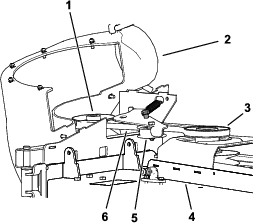
-
Remove the existing bagger belt from the mower-deck pulley.
-
Remove the blower from the mower deck.
-
Remove the existing bagger belt from the blower pulleys.
-
Install the new belt around the blower pulleys (Figure 36).
-
Install the blower onto the blower support.
-
Install the new belt around the mower-deck pulley (Figure 36).
-
Pull back on the spring loaded idler pulley and install the belt onto the spring-loaded idler pulley (Figure 36).
Inspecting the Bagger
| Maintenance Service Interval | Maintenance Procedure |
|---|---|
| After the first 8 hours |
|
| Every 100 hours |
|
-
Check the upper tube, lower tube, bagger hood, and the blower assembly.
Note: Replace these parts if they are cracked or broken.
-
Check the bags, bagger frame, and screen.
Note: Replace any parts that are cracked or broken.
-
Tighten all nuts bolts and screws.
Inspecting the Mower Blades
-
Inspect the mower blades regularly and whenever a blade strikes a foreign object.
-
If blades are badly worn or damaged, install new blades; refer to your machine Operator's Manual for complete blade maintenance.
Replacing the Grass Deflector
Warning
An uncovered discharge opening could allow the machine to throw objects toward you or bystanders, resulting in serious injury. Also, contact with the blade could occur.
Never operate the machine unless you install a mulch plate, discharge deflector, or grass collection system.
-
Disengage the spring from the notch in the deflector bracket and slide the rod out of the welded deck brackets, spring, and discharge deflector (Figure 37).
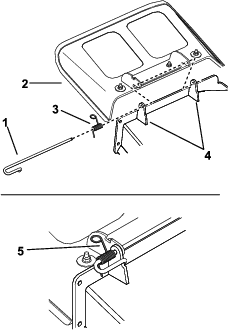
-
Remove the damaged or worn discharge deflector.
-
Position the new discharge deflector with the bracket ends between the welded brackets on the deck as shown in Figure 38.
-
Install the spring onto the straight end of the rod.
-
Position the spring on the rod as shown in Figure 38 so that the shorter spring end comes from under the rod before the bend and going over the rod as it returns from the bend.
-
Lift the loop end of the spring and place it into the notch on the deflector bracket (Figure 38).
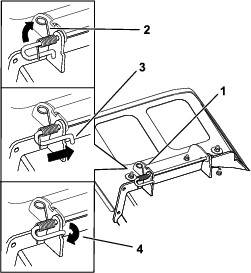
-
Secure the rod and spring assembly by twisting it so that the short end of the rod is behind the front bracket welded to the deck (Figure 38).
Important: The grass deflector must be spring loaded in the down position. Lift the deflector up to test that it snaps to the full down position.
